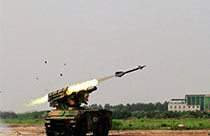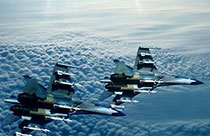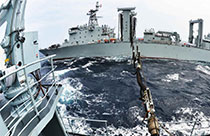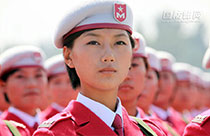

Proportion of naval, air force personnel to rise: expert

An armed police officer bids farewell to his comrades at a train station on Saturday in Handan, Hebei Province as they were discharged from the military. Photo: CFP

China's announcement during Thursday's military parade that it will cut the number of troops in its standing army by 300,000 could be a chance to adjust the ratio of ground, air and naval forces to better cope with modern warfare, experts said Saturday.
A Beijing-based air defense expert told the Global Times that ground troops equipped with outdated armaments would be cut as they were deemed "unfit" for modern warfare.
"The proportion of naval and air forces will increase," said the expert, who asked to remain anonymous.
The number of troops equipped with the latest weaponry will increase, said the expert. Airborne troops, especially, would make a difference in future landing actions and attacks, said the expert, adding that their assault ability would be enhanced when deployed on air transport planes.
He said that army corps, which had previously won battle honors, will likely remain, for example, the 38th Group Army, which made great contributions during the Korean War (1950-53).
Non-combat units, such as medical, communications, and entertainment troupes in the People's Liberation Army (PLA) in each military command would be cut and some logistics departments would be transferred to local areas, a professor surnamed Gong, from the PLA's National Defense University, told the Global Times.
President Xi Jinping announced the military cuts in his speech before Thursday's parade commemorating the end of World War II in Beijing.
Yang Yujun, spokesperson of the Ministry of National Defense, said at a press conference Thursday that "Chinese armed forces will be slimmer but more capable, and their composition will be more scientific."
Protect offshore, open seas
"A reasonable ratio of the land, air and naval forces should be 2:1:1. China traditionally has put a heavy focus on ground forces, which make up 70 percent of the entire PLA," Xu Guangyu, a senior consultant on the Chinese Military Disarmament Control Council, told the Global Times on Saturday.
China has made defense strategies to "protect both offshore and open seas" and should expand its air and naval forces to protect national interests overseas, said Xu.
The navy will not experience any major adjustment as they have continued to upgrade their vessels in recent years to enhance fighting capability, said a Beijing-based naval expert, who also asked for anonymity.
More attention should be placed on expanding aircraft carriers and submarines in the future, the naval expert told the Global Times.
The air defense expert believes that the future commander of a battle could be an officer from air or naval forces, citing the example of the US Pacific Command, which is led by a naval officer.
Military regions
China's military system, which is currently based on seven military regions of ground troops, will also be adjusted accordingly, said the air defense expert, who did not provide further details.
The PLA has seven military regions located in Beijing, Shenyang, Lanzhou, Chengdu, Ji'nan, Nanjing and Guangzhou.
"It [adjusting military regions] will help simplify the process of military commands and strengthen the joint operation ability of different forces," Zhang Junshe, a research fellow at the China Naval Research Institute, told the Global Times.
Hong-Kong-based newspaper the South China Morning Post reported Saturday that the number of military regions would be trimmed to five, with the Shenyang army corps becoming an air commando unit and Nanjing and Ji'nan becoming marine corps.
Authorities have not confirmed this information.
"Any measure that would help trim redundant departments and enhance the joint operations capabilities of the army will be taken," said the naval expert.
According to the defense ministry spokesperson, the military cuts would be completed by 2017 and more reform measures will be released.
"Time is tight and the move should be accelerated. A series of complicated problems needs to be dealt with, such as how to settle the demobilized servicemen and the barracks, and how to store or handle the outdated equipment," said the air defense expert.
According to President Xi's announcement on Thursday, China would cut by 13 percent one of the world's biggest militaries, currently 2.3-million strong.
This will be China's fourth military reduction since the 1980s. In 1985, China downsized its army by more than 1 million.
 'Enemy planes' intercepted by Hongqi-7B air-defense missiles
'Enemy planes' intercepted by Hongqi-7B air-defense missiles Blind date with bikini girls in Nanjing
Blind date with bikini girls in Nanjing Amazing photos of Chinese fighter jets
Amazing photos of Chinese fighter jets Chinese soldiers participate in training for V-Day parade
Chinese soldiers participate in training for V-Day parade Painting: Lonely women in Forbidden City
Painting: Lonely women in Forbidden City China and Russia hold joint drill in Sea of Japan
China and Russia hold joint drill in Sea of Japan 'Goddess' in Taiwan McDonald's
'Goddess' in Taiwan McDonald's Female soldiers at military parades
Female soldiers at military parades Photos of campus belle doing splits go viral
Photos of campus belle doing splits go viral Best blade forward
Best blade forward Infographic: Parsing China's massive V-day parade
Infographic: Parsing China's massive V-day parade Giant panda cub receives medical care in Guangzhou
Giant panda cub receives medical care in Guangzhou China celebrates 70th Anniversary of Victory of World Anti-Fascist War
China celebrates 70th Anniversary of Victory of World Anti-Fascist WarDay|Week